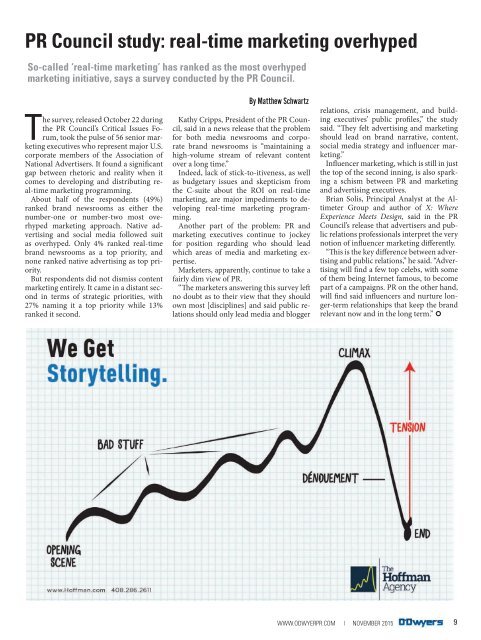Communications & New Media Nov 2015 Vol 29 No 11
odwyers-magazine-november-2015
odwyers-magazine-november-2015
Create successful ePaper yourself
Turn your PDF publications into a flip-book with our unique Google optimized e-Paper software.
PR Council study: real-time marketing overhyped<br />
So-called ‘real-time marketing’ has ranked as the most overhyped<br />
marketing initiative, says a survey conducted by the PR Council.<br />
The survey, released October 22 during<br />
the PR Council’s Critical Issues Forum,<br />
took the pulse of 56 senior marketing<br />
executives who represent major U.S.<br />
corporate members of the Association of<br />
National Advertisers. It found a significant<br />
gap between rhetoric and reality when it<br />
comes to developing and distributing real-time<br />
marketing programming.<br />
About half of the respondents (49%)<br />
ranked brand newsrooms as either the<br />
number-one or number-two most overhyped<br />
marketing approach. Native advertising<br />
and social media followed suit<br />
as overhyped. Only 4% ranked real-time<br />
brand newsrooms as a top priority, and<br />
none ranked native advertising as top priority.<br />
But respondents did not dismiss content<br />
marketing entirely. It came in a distant second<br />
in terms of strategic priorities, with<br />
27% naming it a top priority while 13%<br />
ranked it second.<br />
By Matthew Schwartz<br />
Kathy Cripps, President of the PR Council,<br />
said in a news release that the problem<br />
for both media newsrooms and corporate<br />
brand newsrooms is “maintaining a<br />
high-volume stream of relevant content<br />
over a long time.”<br />
Indeed, lack of stick-to-itiveness, as well<br />
as budgetary issues and skepticism from<br />
the C-suite about the ROI on real-time<br />
marketing, are major impediments to developing<br />
real-time marketing programming.<br />
Another part of the problem: PR and<br />
marketing executives continue to jockey<br />
for position regarding who should lead<br />
which areas of media and marketing expertise.<br />
Marketers, apparently, continue to take a<br />
fairly dim view of PR.<br />
“The marketers answering this survey left<br />
no doubt as to their view that they should<br />
own most [disciplines] and said public relations<br />
should only lead media and blogger<br />
relations, crisis management, and building<br />
executives’ public profiles,” the study<br />
said. “They felt advertising and marketing<br />
should lead on brand narrative, content,<br />
social media strategy and influencer marketing.”<br />
Influencer marketing, which is still in just<br />
the top of the second inning, is also sparking<br />
a schism between PR and marketing<br />
and advertising executives.<br />
Brian Solis, Principal Analyst at the Altimeter<br />
Group and author of X: Where<br />
Experience Meets Design, said in the PR<br />
Council’s release that advertisers and public<br />
relations professionals interpret the very<br />
notion of influencer marketing differently.<br />
“This is the key difference between advertising<br />
and public relations,” he said. “Advertising<br />
will find a few top celebs, with some<br />
of them being Internet famous, to become<br />
part of a campaigns. PR on the other hand,<br />
will find said influencers and nurture longer-term<br />
relationships that keep the brand<br />
relevant now and in the long term.” <br />
www.ODwyERPR.COM | NOVEMBER <strong>2015</strong> 9


